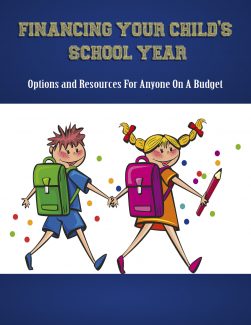
 License Type: Private Label Rights
License Type: Private Label Rights  File Type: ZIP
File Type: ZIP
 SKU: 60438
SKU: 60438  Shipping: Online Download
Shipping: Online Download
Sample Content Preview
Financing Your Child's School Year
According to Huntington Bank’s Backpack Index, in 2015 parents paid on average over one grand per child in school expenses, fees, and supplies (http://huntington-ir.com/ne/news/hban072915.htm). High school can be as much as $1500 per year for each student depending on the activates they’re involved in.
It’s clear that public school isn’t free after all, so what is a parent on a limited budget to do about it? The first thing to do is to accept it, and the next thing to do is to plan for it. If you’re a low-income parent, keep reading; there will be options and resources for you too.
Items You’ll Likely Be Responsible For in Public School
You may be surprised to learn about how much each parent is expected to buy for each child in school. Much of this is due to less funding for public schools and also simply technological advances and an unwillingness for local governments to raise taxes to pay for the additional expenses.
* Books – Often you will need to pay book fees for your child to get to use the books at school. Some schools now have the option of electronic books that your child will keep on a tablet, but others still have regular books.
Each district and school within the district is often very different. The fees can be as little as a hundred dollars per child, and in some cases, much more. A parent in Indiana reported spending more than a thousand dollars in book fees for her five kids: http://indianapublicmedia.org/stateimpact/2014/09/24/textbook-fees/
So, remember, it all adds up.
* Uniforms – Many public schools require that students wear their uniform. This can become an additional expense for parents that they weren’t planning for, with each uniform costing upwards of $100. And your child will need more than one to be clean. Even schools that do not require uniforms have outfits they expect your child to buy for gym class or PE.
* Instruments – If your child will be in any type of music program, you’ll be responsible for buying or renting the instruments. Depending on which one your child ends up playing (which without having lessons already they won’t get to pick on their own), it can cost thousands or on average $100 a month to rent from a local rent shop.
* Electronics – Some schools require that your child has a laptop or tablet or both. It depends on your area. Often the schools supply them, but charge a fee for using them. You can usually use your own if they’re approved by the school too. So, if your child already has these devices, ask if they can use theirs to avoid that fee.
* General Supplies – Today, through middle school, (and some high schools), most parents are being asked to provide general supplies such as hand sanitizer, paper towels, art supplies, toilet paper, and more to help keep the school full of supplies throughout the year.
* Activity Fees – If your child is involved in any type of activity, even field day, there is likely to be a fee involved that is going to be paid up front at the start of the year. In some cases, such as band, football, cheer and those types of activities, it can cost hundreds of dollars a month per child to be involved.
* Classroom Fees – Certain classes that have extra equipment such as science class may require an additional classroom fee, to help pay for the maintenance of the class and the equipment needed to conduct the class correctly.
* Parking Fees – If your high school student wants to drive to school, a parking pass can put you back a couple hundred dollars. This is true even in districts that don’t have a good bussing system.
* Bussing Fees – Some school districts have buses but charge parents a monthly fee for each child that takes a bus. These fees can range from 100 dollars a year to even a couple thousand a year, depending on where you live.
* Testing Fees – To pass dual credit classes or honors classes and get college credit for them, your child will have to pay a testing fee. These range from $100 dollars and less per honors test. While this isn’t directly related to your school, it is an important thing to consider as soon as you can. The tests for college entrance aren’t free. Neither is applying to a college. Everyone has to pay a fee for the test, and everyone pays a fee for each college application.
It can truly be overwhelming to realize that public school isn’t free. The best thing you can do is to find out how your school works before your child goes to the school, so you will be prepared. You can call the school the year before your child is to go, and ask them about costs in relation to the things your child wants to be involved in.
Don’t call during busy times such as the first day of the school year or the end of the school year. They should be happy to send you current information, realizing that it will probably be more expensive the following year. If you can’t get information this way, ask friends with older kids to clue you in.
How to Create a Budget with School Expenses in Mind
Once you know what is expected of you as a parent of a public-school student, it’ll be a lot easier to budget for it. Find out what last year’s list was. Contact any specialty classes to find out the fees if you can’t get the information from the admin office of the school.
You’ll need to know everything that your child may need, plus the extras as mentioned before - such as whether your child will be in a band, sports, choir or other activities. Whatever figure you come up with, multiply it by 1.5 so you’ll have a buffer, then multiply it by how many kids you’ll have in school.
Including the above, let’s make a list of the potential expenses for your child’s public school journey.
- License: Private Label Rights
- Category:Ebooks
- Tags:2017 Ebooks Private Label Rights







